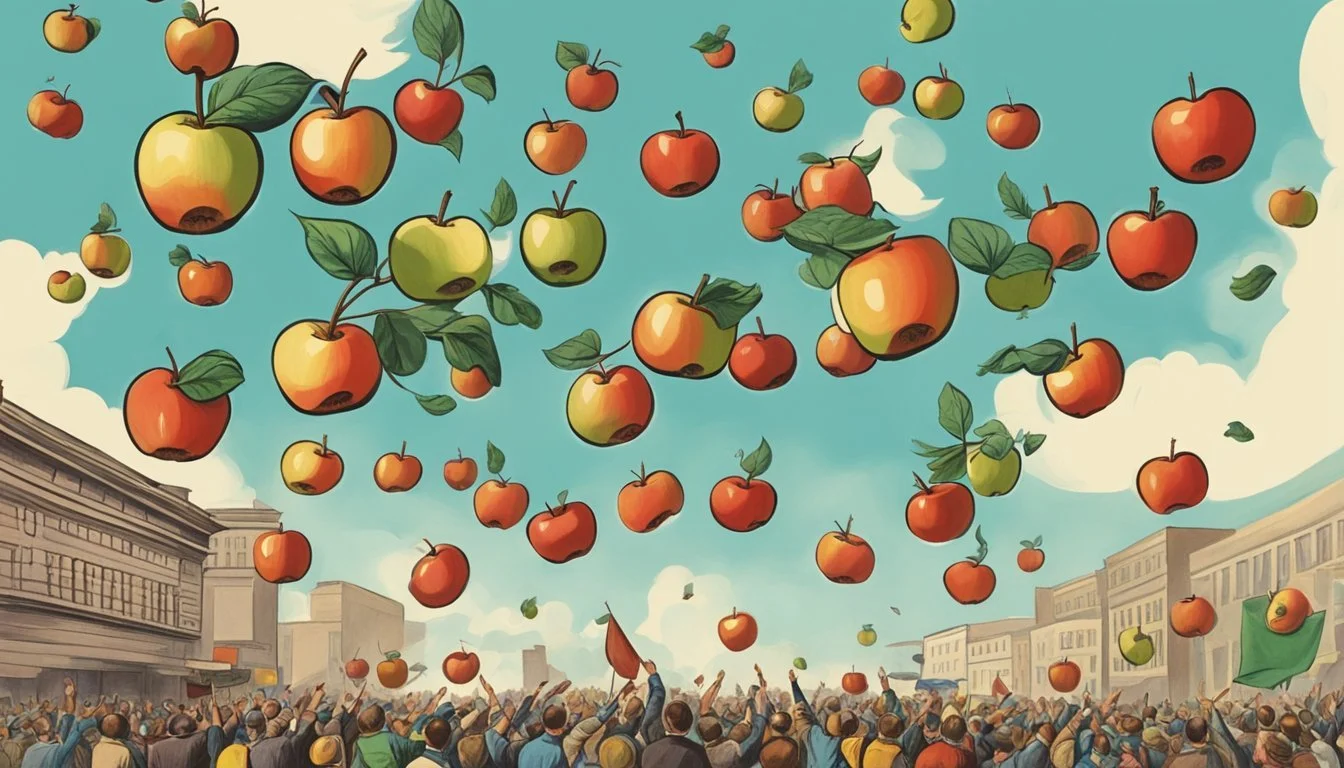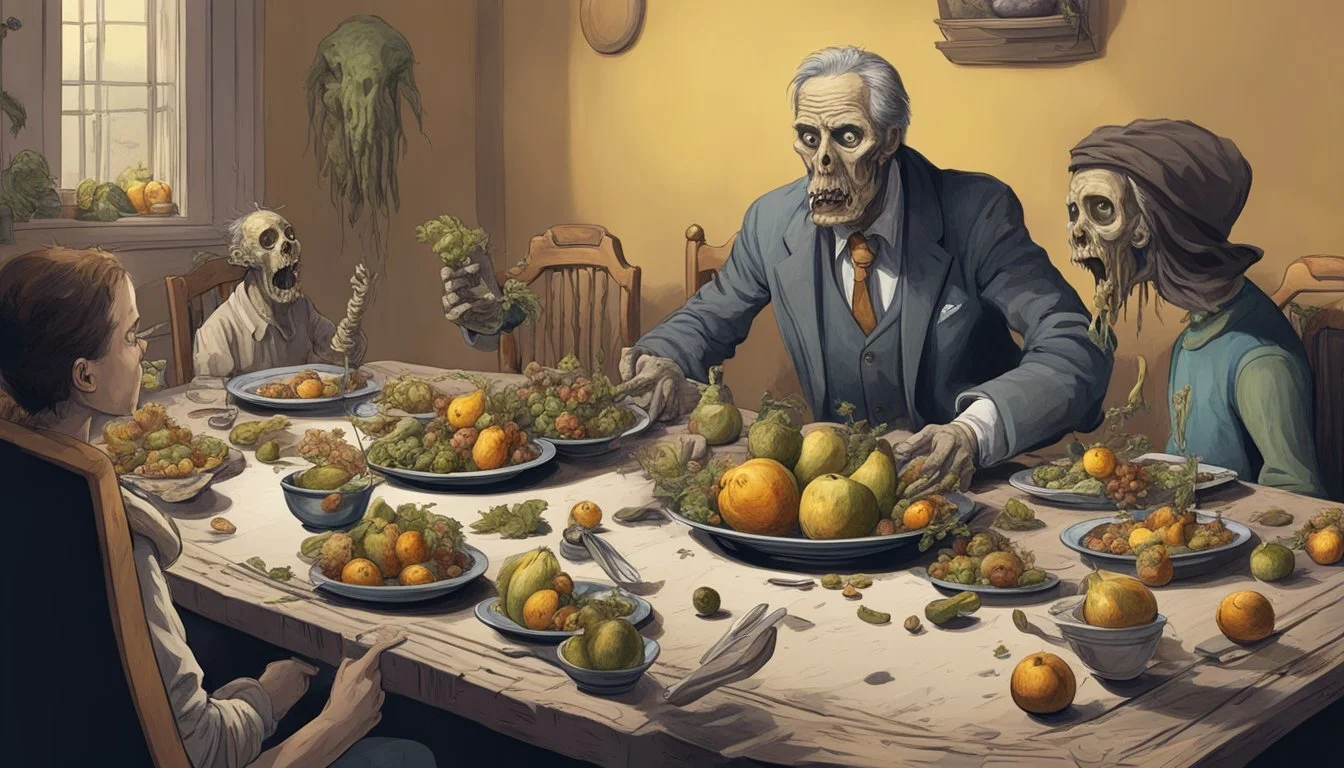10 Times Food Was Used As A Weapon
Bizarre Instances In History
Throughout history, food has emerged as a pivotal instrument in conflicts and power struggles. From ancient strategies involving sieges and blockades to more recent political maneuvers, the manipulation of food supplies has often been a calculated method to exert control or influence outcomes.
The use of food as a weapon can be just as impactful as traditional warfare tactics, influencing not only the physical well-being of populations but also their morale and resolve. Examining instances where food was used strategically offers insight into the lengths to which parties will go to achieve their aims.
1) Battle of the Oranges
The Battle of the Oranges is an annual festival in Ivrea, Northern Italy.
From the Sunday of Carnival to Fat Tuesday, participants engage in a massive orange-throwing fight. The event is a historical reenactment, commemorating a medieval rebellion against feudal lords.
Originally, beans were used in these battles. By the 19th century, oranges had replaced them as the ammunition of choice.
Thousands of participants and spectators flock to Ivrea each year. In recent years, the event has drawn crowds of nearly 19,700 people on its busiest days.
Participants face off in teams, hurling citrus in an attempt to "defeat" their opponents. The fruit fight is intense, often leading to minor injuries like cuts and bruises. The oranges are transported into the town on horse-drawn carriages, heightening the historic atmosphere.
2) The Great Emu War's Throwing of Bread
During the Great Emu War of 1932, Australian soldiers faced the challenge of controlling emu populations destroying crops.
To combat the emus, some soldiers tried unconventional methods, including using bread as bait. The idea was to lure the birds into a confined area.
Once the emus gathered, soldiers would then attempt to capture or shoot them. This approach, however, proved to be ineffective. The emus often scattered before any significant harm could be done to them.
The use of bread, while creative, highlighted the difficulties in managing wildlife with non-lethal methods. It showcased the resilience and unpredictability of the emus.
Despite these efforts, the emus continued to outsmart the soldiers, leading to a widespread perception of the campaign as a failure.
3) 1966 Ejecting Apples at Protesters
In October 1966, a protest took place at a Loblaws store in downtown Toronto. The demonstration centered around rising grocery prices, which had become a significant concern for many residents.
To make their voices heard, some protestors chose an unusual method of dissent. They hurled apples at those who disagreed with their cause. This act symbolized their frustration and anger, drawing considerable attention from bystanders and the media.
Though the protest did not draw as many participants as expected, the use of apples as projectiles made headlines. It highlighted the growing desperation of consumers affected by inflation.
The incident at Loblaws became a noteworthy example of using everyday items as tools of protest. This event underscored how people can turn common objects into powerful symbols of resistance.
The protest did not lead to immediate changes but left a lasting impression regarding the lengths to which individuals would go to advocate for fair prices. The use of apples in Toronto's protest remains a vivid memory, illustrating the emotional intensity of the participants' struggle.
4) Europe's Tomato Festival
Every year, the small town of Buñol in Spain hosts La Tomatina, the world's biggest tomato fight.
Held on the last Wednesday of August, thousands of participants gather to throw overripe tomatoes at each other in a chaotic yet joyful event.
This tradition began in the 1940s and quickly grew into a popular and unique festival.
The origins of La Tomatina are linked to a food fight among friends, later becoming a major tourist attraction.
With over 100 metric tons of tomatoes used, the streets of Buñol are transformed into rivers of red tomato paste.
Notably, from 2013 onwards, the festival has enforced an upper limit on the number of attendees to manage the crowds.
5) Custard Pie Fight in Classic Cinema
One of the most iconic uses of custard pies in cinema emerged from early comedic films. These pie fights provided both visual humor and physical comedy, becoming a staple in classic Hollywood.
The 1927 silent film "The Battle of the Century" by Laurel and Hardy is renowned for its epic custard pie fight. This scene is considered one of the largest ever staged, utilizing around 4,000 pies.
Custard pie fights offered a whimsical and exaggerated way to portray conflict in films. They added a layer of innocent absurdity that appealed widely to audiences of all ages.
The tradition of pie fights continued in cinema, influenced by their successes in earlier films. These scenes often featured slapstick scenarios, where characters found themselves unexpectedly hit by custard pies, eliciting laughter.
Classic cinema leveraged these pie fights not just for laughs but also as a memorable visual spectacle. They remain a beloved part of film history.
6) 1945 Yeast Bomb Delivery
In 1945, scientists experimented with unconventional warfare tactics involving biological components. One notable experiment was the yeast bomb delivery. The idea stemmed from the need to innovate beyond conventional bombs during World War II.
Researchers aimed to develop a biological weapon that could be dispersed using yeast. This involved creating a delivery mechanism that could efficiently release yeast spores over a targeted area.
These specialized bombs were designed to spread biological agents in such a way that would incapacitate enemy forces without causing immediate destruction. This focus on minimal destruction was intended to disrupt enemy food supplies and create chaos.
The yeast bomb concept required extensive testing to ensure effective dissemination. Scientists had to determine the appropriate conditions for yeast spore survival and spread. They also tested different types of aircraft and delivery methods.
Though the yeast bomb delivery was never deployed in actual combat, it remains a significant example of biological warfare experimentation during WWII. This innovative approach demonstrated the lengths to which researchers would go to explore new methods of warfare.
7) Molasses Flood of 1919
On January 15, 1919, Boston's North End became the site of a tragic disaster. A massive storage tank filled with 2.3 million gallons of molasses burst, releasing a wave of the sticky liquid through the streets.
The molasses, weighing around 13,000 short tons, caused significant destruction. Buildings were shattered, and streets were flooded, making rescue efforts exceedingly difficult.
The wave of molasses moved at an estimated 35 miles per hour, quickly engulfing everything in its path. It killed 21 people and injured 150 others.
This incident revealed flaws in industrial safety standards of the time. The storage tank, built in 1915, had been poorly constructed and inadequately maintained.
The Great Molasses Flood remains a poignant reminder of the importance of proper safety measures in industrial operations.
8) World War II Potato Grenades
During World War II, unconventional tactics sometimes came into play. One noteworthy incident involved the USS O'Bannon, a U.S. Navy destroyer engaged in combat with a Japanese submarine.
The American crew found themselves without immediate access to firearms. Their solution was to use potatoes as makeshift grenades.
They threw the potatoes onto the Japanese submarine's deck. The Japanese crew, mistaking the potatoes for grenades, frantically threw them back in defense.
This caused confusion and distraction, allowing the O'Bannon to gain a strategic advantage. The episode of the "potato grenades" became a memorable anecdote in wartime history.
This quick thinking underscores how resourcefulness was crucial during the war.
9) The Boston Tea Party
The Boston Tea Party took place on December 16, 1773. American colonists, particularly the Sons of Liberty, protested against British taxation by boarding three British ships and dumping 342 chests of tea into Boston Harbor. The event was a reaction to the Tea Act, which allowed the East India Company to sell tea in the colonies without paying taxes, apart from those imposed by the Townshend Acts.
Disguised as Mohawk Indians, the colonists chose this method to conceal their identity. This act of defiance was intended to send a clear message against "taxation without representation," which they believed violated their rights as Englishmen.
The destruction of the tea represented a significant financial loss for the British, amounting to about £10,000 (over $1 million today). This incident escalated tensions between Britain and the American colonies, leading to severe repercussions such as the Intolerable Acts. These measures further united the colonies against British rule, laying the groundwork for the American Revolution.
By using tea as a symbol of economic and political rebellion, the Boston Tea Party remains an iconic example of food being used as a weapon in the fight for independence.
10) Punk Rock's Sandwich Throwing
In the world of punk rock, concerts are known for their chaotic and energetic atmospheres. Fans often take this opportunity to express themselves in unusual ways. One of these ways has involved throwing sandwiches during live performances.
Band members sometimes encourage this behavior, seeing it as a unique form of interaction with the audience.
The tradition of sandwich throwing is thought to have started as a humorous act, becoming a quirky staple in some punk rock circles. It’s not just confined to sandwiches; other food items have made appearances as well.
Audience members bring their own food items to shows specifically for this purpose, heightening the sense of rebellion at punk rock concerts.
Performers and fans alike view this as part of the punk rock spirit, embracing a sense of fun and unpredictability. While unconventional, it highlights the community’s penchant for the unexpected.
Such acts contribute to the lore and legend of punk rock, making these concerts unforgettable experiences.
Historical Instances of Food as a Weapon
Food has been a tool of power and control throughout history. Using food strategically during conflicts has altered the outcomes of wars and subjected populations to severe hardships.
Ancient Food Warfare Tactics
In ancient times, armies often targeted food supplies to weaken their enemies. Scorched earth policies were common. For instance, the Romans would destroy crops and livestock during their campaigns. This left enemy soldiers without nourishment and civilians suffering from hunger.
The Greeks, especially during the Peloponnesian War, would also use similar tactics. They would cut off food supplies to besieged cities. This method proved effective in forcing surrenders without extensive direct combat.
Medieval Siege Strategies Involving Food
During the medieval period, sieges were typical strategies in warfare. Attacking forces would block all supply routes to the besieged city, ensuring no food or resources got in. One famous example is the Siege of Leningrad during World War II.
In the Medieval Siege of Rochester Castle in 1215, King John used starvation as a weapon. He cut off supplies, leading to the castle's eventual surrender. Such tactics were brutal and caused immense suffering to the trapped populace.
Using food as a weapon during sieges often resulted in high civilian casualties and prolonged suffering, making it a feared but effective tactic.
Psychological Impact of Food as a Weapon
The use of food as a weapon can have severe psychological effects on populations. Hunger and malnutrition can lead to desperation and despair.
Starvation can cause immense stress, leading individuals to make extreme decisions. During the Siege of Leningrad in World War II, people were forced to eat rats, dogs, and even other humans.
Food scarcity often generates a climate of fear and uncertainty. The constant worry about where the next meal will come from can break down mental resilience.
The prolonged stress of famine can lead to widespread mental health issues. Anxiety, depression, and post-traumatic stress disorder (PTSD) are common outcomes in deprived populations.
Key Psychological Impacts:
Desperation: Acute food deprivation forces people into unimaginable choices.
Mental Health Disorders: Increased incidence of anxiety, depression, and PTSD.
Breakdown of Social Norms: Families and communities can be torn apart by the struggle for survival.
Modern Examples and Ethical Considerations
In recent years, the role of food in political and economic conflicts has raised ethical concerns. This section covers specific incidents where food was weaponized and the debates they ignited about ethics and morality in food distribution.
Recent Incidents
Blocking of Aid to Yemen: The ongoing conflict in Yemen saw the blocking of food aid as a strategy. Humanitarian organizations reported that warring factions used food scarcity to control populations.
Sanctions Against North Korea: Economic sanctions limited North Korea's access to food imports. This created significant food shortages, affecting millions of civilians, and raised questions about the humanitarian impact of such policies.
Grain Destruction in Ukraine Conflict: During the conflict between Russia and Ukraine, incidents of grain stock destruction were reported. These actions aimed to destabilize food security in the region, leading to shortages and high prices.
Debates and Ethics
Humanitarian vs. Political Needs: The ethical dilemma arises when food aid is restricted for political gains. Critics argue that humanitarian needs should always take precedence over political strategies, especially in conflict zones where civilians suffer the most.
Marketing to Vulnerable Populations: In peacetime, ethical considerations extend to marketing practices. There is growing concern about targeting vulnerable groups, like children, with unhealthy food options. Ethical marketing practices are essential to protect public health.
Food Production Practices: The broader ethical discussion includes how food is produced. Issues like the treatment of animals, use of pesticides, and environmental impact are central to creating ethical food systems. Ensuring fair labor practices and sustainability are essential components of this conversation.









